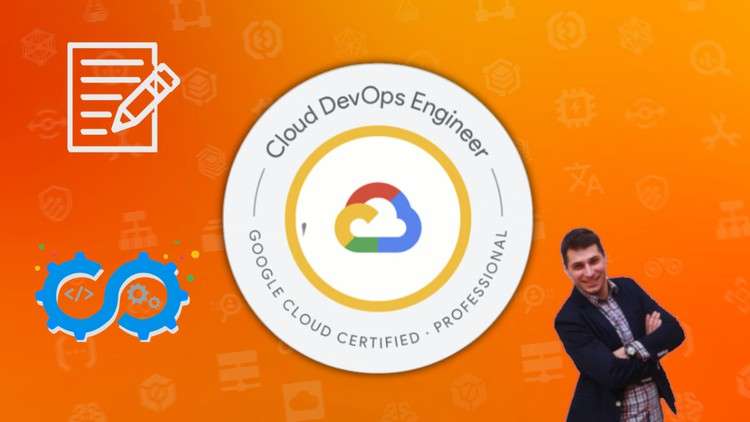
Get ready for Google Cloud DevOps Engineer certification with 185 real test questions insights into best practices!
What you will learn
Achieve Google Cloud Professional DevOps Certification
Master Google Cloud services tailored for DevOps
Set up a robust CI/CD pipeline using GCP services
Access downloadable slides and code materials
Build a comprehensive DevOps CI/CD pipeline with CSR, Cloud Build, and Container Registry
Explore advanced monitoring and logging services for efficient resource management
Participate in hands-on demos by implementing five CI/CD pipelines
Ensure secure container deployment through container scanning and binary authorization
Acquire insights into DevOps and SRE best practices and principles
Description
Are you gearing up for the Google Professional Cloud DevOps Engineer certification exam? Welcome to the ideal place to evaluate your preparedness through our specially designed practice exams.
Our tests assess your proficiency in building scalable and highly available applications utilizing Google’s robust tools and adhering to the industry’s best practices.
Succeeding in this exam will spotlight your expertise in cloud-native applications. It will showcase your ability to employ the right tools for development, leverage managed services, and utilize cutting-edge databases.
Why is this significant? Because it amplifies your career prospects. Professionals with these skills are in high demand in today’s industry.
In this course, we present a collection of practice tests comprising both essential knowledge questions that every cloud development professional must know, and specialized queries. Here’s what we offer:
- 185 unique, high-quality test questions.
- Detailed explanations for both correct and incorrect answers.
- Insights into best practices, enriched with references to official guidelines.
- Importantly, our materials do not include outdated ‘Case Studies’ questions, which have been officially excluded from the exam by Google.
Our content is carefully curated to enhance your understanding and prime you for success with our well-constructed materials.
So, don’t hesitate. Embark on this journey and put your knowledge to the test with our practice exams!
Quality speaks for itself..
SAMPLE QUESTION:
You recently deployed your application on Google Kubernetes Engine (GKE) and now need to release a new version of the application. You need the ability to instantly roll back to the previous version of the application in case there are issues with the new version.
Which deployment model should you use?
- A. Perform a rolling deployment, and test your new application after the deployment is complete.
- B. Perform A/B testing, and test your application periodically after the deployment is complete.
- C. Perform a canary deployment, and test your new application periodically after the new version is deployed.
- D. Perform a blue/green deployment, and test your new application after the deployment is complete.
What’s your guess? Scroll below for the answer..
Explanation
Incorrect Answers:
A. Perform a rolling deployment, and test your new application after the deployment is complete.
Involves gradually updating pods with the new version of the application, replacing the old version incrementally. This method minimizes downtime, as the service remains available during the deployment. However, if issues arise with the new version, rolling back is not instant and can be complex. The process would involve reversing the rollout, which is time-consuming and may not be suitable for scenarios where immediate fallback is crucial.
B. Perform A/B testing, and test your application periodically after the deployment is complete.
Is a strategy where two or more versions of the application are deployed simultaneously, and traffic is split between them. This model is typically used for testing user response to new features or changes. It’s more about gathering data and insights rather than quick rollback capabilities. In case of any issues with the new version, an immediate switch back to the old version isn’t the primary focus of A/B testing, making it less ideal for situations requiring rapid response to deployment problems.
C. Perform a canary deployment, and test your new application periodically after the new version is deployed.
Sees the new version released to a small subset of users first. If this initial release proves successful, the new version is then rolled out to the entire user base. The advantage of this approach is that it reduces the risk of a faulty update affecting all users at once, as any problems can be identified and fixed during the initial, smaller release. However, like A/B testing, canary deployments don’t emphasize instant rollback. If the new version encounters issues, rolling back to the old version across the entire user base would not be as immediate as needed.
Correct answer:
D. Perform a blue/green deployment, and test your new application after the deployment is complete.
Operates with two identical environments, one running the current (blue) version and the other the new (green) version of the application. After deploying the green version, traffic is switched over from blue to green. If the new version encounters any problems, traffic can be instantly reverted back to the blue environment. This approach greatly minimizes downtime and risk, as the old version remains operational and can be quickly reinstated if necessary. The primary downside is the need for double the resources, as both environments run concurrently. Despite this, the level of control and safety it offers, especially for instant rollbacks, often justifies the additional resource requirement.
Links:
Application deployment and testing strategies
Links to Documentation
Welcome to the best practice exams to help you prepare for your Google Professional Cloud DevOps Engineer exam.
• You can retake the exams as many times as you want
• This is a huge original question bank
• You get support from instructor if you have questions
• Each question has a detailed explanation
• Mobile-compatible with the Udemy app
• 30-days money-back guarantee if you’re not satisfied
We hope that by now you’re convinced! And there are a lot more questions inside the course.
Happy learning and best of luck for yourGoogle Professional Cloud DevOps Engineer exam!